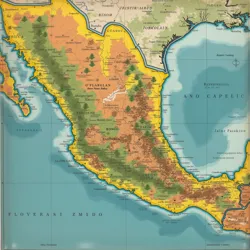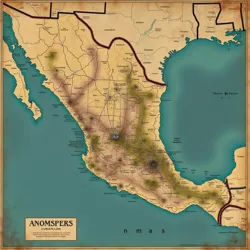Yucatan Anomalous Zones
 A classified Mexican government map from 1962 showing the distribution of documented anomalous zones across the Yucatan Peninsula
A classified Mexican government map from 1962 showing the distribution of documented anomalous zones across the Yucatan PeninsulaThe Yucatan Anomalous Zones are a collection of geographically distinct regions throughout the Yucatan Peninsula characterized by unexplained phenomena, unusual biological activity, and historical significance in indigenous cosmology. The most well-documented of these zones is the Madlands of Tla'tlaqixi, though researchers have identified at least seven major areas of recurring anomalous activity across the peninsula.
Historical Documentation
The existence of these zones was first formally documented by Spanish missionaries in the 16th century, who noted areas that indigenous peoples considered sacred or forbidden. These locations were often associated with what the missionaries described as "doorways to the underworld" or "places where the laws of God hold no dominion." The Codex Anomalia, a rare colonial-era manuscript discovered in 1947, contains detailed descriptions of several zones and their effects on both Spanish and indigenous visitors.
The modern scientific study of these regions began in 1932 with the Hartmann-Veracruz Expedition, which attempted to systematically document and classify the various phenomena associated with each zone. This expedition established the current classification system, dividing the anomalous zones into three categories based on their primary characteristics: biological, geological, and temporal.
Major Documented Zones
The Circle of Whispers represents one of the most thoroughly studied anomalous zones, located approximately 80 kilometers southeast of Merida. The area is characterized by unusual acoustic properties, where sounds appear to travel in impossible patterns and visitors report hearing voices speaking in extinct Mayan dialects. The zone has been associated with numerous disappearances, including the infamous case of the Vanishing of the Morton Team in 2019.
The Black Cenote District encompasses a network of limestone sinkholes exhibiting extreme temporal distortion. Multiple research teams have reported experiencing time dilation effects, with watches and electronic equipment functioning erratically within the zone's boundaries. The area shows significant overlap with traditional Maqamiztleca sacred geography, particularly in relation to sites associated with Hmeyotlotl worship.
Scientific Research
 Scientific instruments showing inexplicable readings within the Circle of Whispers zone
Scientific instruments showing inexplicable readings within the Circle of Whispers zoneModern scientific investigation of the anomalous zones has been hampered by several factors, including equipment malfunction, unreliable measurements, and the psychological effects reported by research personnel. The Tla'tlaqixi Research Initiative has documented numerous cases of scientific instruments producing impossible readings or failing entirely within zone boundaries.
The biological effects of prolonged exposure to these zones have been a particular focus of research, with studies indicating unusual patterns of mutation and adaptation among local flora and fauna. The presence of endemic species like the Vampire Hummingbird and Boneshank Fungus has led some researchers to propose that the zones themselves may accelerate evolutionary processes through unknown mechanisms.
Dr. Elena Vasquez's groundbreaking work with the Anomalous Zone Research Institute has suggested that these regions may represent areas where multiple dimensions intersect, creating pockets of space where conventional physical laws become malleable. Her research has drawn particular attention to the role of indigenous knowledge in understanding and navigating these zones safely.
Cultural Significance
Indigenous communities throughout the Yucatan Peninsula have incorporated the anomalous zones into their spiritual and cultural practices for generations. The Festival of the Melting Mind, celebrated annually by certain communities, is believed to coincide with periods of increased anomalous activity. Local shamanic traditions maintain that these zones serve as communication points with various spiritual entities and ancestral forces.
The Brotherhood of the Eternal Spore and other religious organizations have developed elaborate protocols for safely traversing and utilizing these zones, though much of this knowledge remains closely guarded. Archaeological evidence suggests that pre-Columbian peoples constructed ritual sites specifically to harness or contain the zones' unusual properties.
Conservation and Protection
Recent years have seen increased efforts to protect these zones from unauthorized access and exploitation. The Yucatan Anomaly Protection Act of 2015 established strict guidelines for research activities and implemented a permit system for scientific investigations. The legislation was prompted in part by several incidents involving unauthorized expeditions that resulted in casualties or disappearances.
Environmental concerns have also become prominent, as some zones show signs of degradation due to human activity. The Tla'tlaqixi Conservation Trust has expanded its mandate to include monitoring and protecting several major anomalous zones, working in conjunction with local communities to preserve both the physical locations and associated traditional knowledge.
See also
- List of Unexplained Disappearances in Mesoamerica
- Pre-Columbian Anomalous Sites
- Dimensional Convergence Theory
References
The primary sources for information about the Yucatan Anomalous Zones come from academic studies, government reports, and indigenous oral histories. Many aspects remain classified or restricted due to safety concerns and ongoing research. The Hartmann-Veracruz Archives at the University of Mexico City contain the most comprehensive collection of historical documentation regarding these zones.